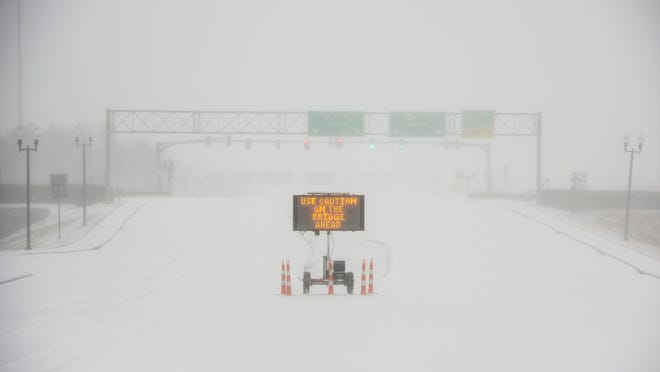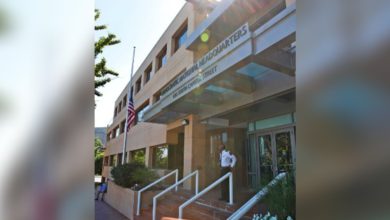
An "unprecedented" winter storm continued its assault on the nation Monday, leaving millions without power in Texas and wreaking travel havoc across a wide swath of the central and southern USA because of heavy snow and ice.
More than 150 million people were under a winter storm warning, winter weather advisory or ice storm warning in 25 states, stretching over 2,000 miles from southern Texas to northern Maine, the National Weather Service said.
Bitter, record-smashing cold accompanied the storm across the central USA. Hundreds of daily record low temperatures have been or will be broken during this prolonged "polar plunge," the weather service said, "with some February and even all-time low temperature records in jeopardy."
More than 50 million people could see temperatures dip below zero during the next several days, according to the Capital Weather Gang.
Power outages were widespread Monday. In Texas alone, more than 2.7 million customers were in the dark as of noon local time, according to poweroutage.us, a utility tracking site.
Rotating power outages were initiated by the Electric Reliability Council of Texas, or ERCOT, Monday morning, meaning thousands went without electricity for short periods as temperatures fell into the teens near Dallas and Houston.
"We urge Texans to put safety first," the council tweeted as it urged residents to reduce electricity use. ERCOT manages the flow of electric power in the state.
Matt Varble in the Dallas suburb of Las Colinas told The Dallas Morning News his power had gone out a couple of times Monday morning. The second time, it went out around 3:30 a.m. and hadn’t returned as of 7 a.m.
“It’s starting to get very cold inside my house,” Varble told the newspaper. “I lived in the north for a very long time and nothing like this has ever happened when I lived in New York, Ohio and Illinois.”
Houston, where temperatures hit the 70s last Tuesday, saw readings in the teens Monday morning, prompting officials to advise residents to prepare for hazardous roads that could be similar to those experienced after a Category 5 hurricane.
In Texas, the storm could be a "once in a generation" event when factoring in the brutally cold conditions, AccuWeather meteorologist Brandon Buckingham said.
San Angelo, Texas, had its snowiest day recorded Sunday – 10.1 inches, the weather service said.
Thundersnow was reported early Monday as far south as the Gulf Coast in Galveston, Texas, and Lake Charles, Louisiana, Weather.com reported.
Texas Gov. Greg Abbott, Oklahoma Gov. Kevin Stitt and Arkansas Gov. Asa Hutchinson each activated National Guard units to assist state agencies with tasks including rescuing stranded drivers.
In a statement, President Joe Biden declared an emergency in Texas and ordered federal assistance to aid state and local response efforts. The declaration allows the Department of Homeland Security and the Federal Emergency Management Agency to coordinate disaster relief efforts and provide assistance, equipment and resources to those affected by the storm.
Though the snow was expected to wind down across Texas on Monday, heavy snow and freezing rain were forecast to advance northeastward from the Mississippi and Ohio Valleys to the Northeast, the weather service said. "A large swath of 6 to 12 inches of snow is forecast from the Ohio Valley and eastern Great Lakes to northern New England," according to the weather service.
As of 1:45 p.m. EST, FlightAware had reported more than 5,600 canceled flights across the country for Monday and more than 3,200 delays. More than 2,400 cancellations are predicted for Tuesday. George Bush International Airport in Houston closed Monday morning because of ice accumulation on runways. Austin-Bergstrom International Airport was also closed.
Tuesday's forecast high of 38 degrees in New Orleans would tie 1899 as the coldest Mardi Gras on record, the weather service said. Most celebrations are canceled this year because of the COVID-19 pandemic.
In the Pacific Northwest, hundreds of thousands of people remained without power after a weekend winter storm blanketed the region with ice and snow and made travel treacherous. About 300,000 people were powerless in Oregon, poweroutage.us reported. Snow-packed roads, downed trees and power lines made travel in the Portland area treacherous.
Blocked storm drains in Washington state and Idaho raised concerns about flooding.
More than 70% of the USA was snow-covered as of Monday afternoon, the weather service reported.
In another cruel weather twist Monday afternoon, portions of Florida, Alabama and Georgia were under a tornado watch, meaning weather conditions were favorable for tornadoes to develop.
Unfortunately, a second winter storm that hit the Northwest on Monday was forecast to bring more snow and ice to parts of the South, Midwest and East this week, weather.com said.
Contributing: The Associated Press
Source link











